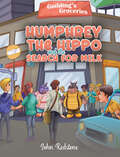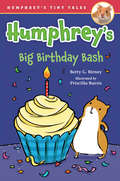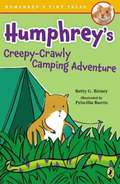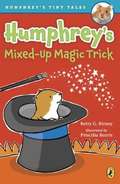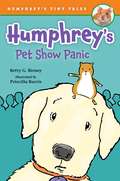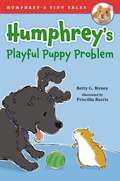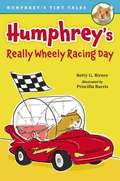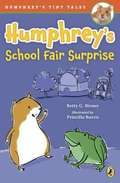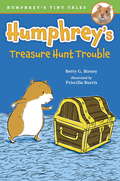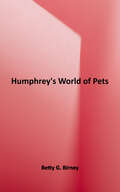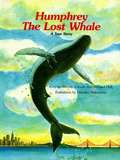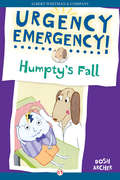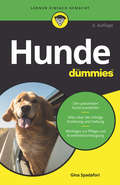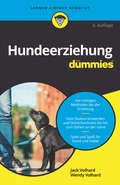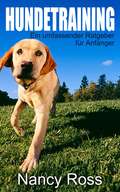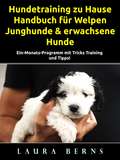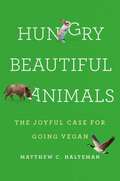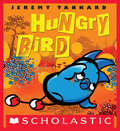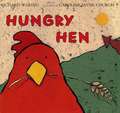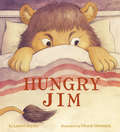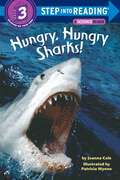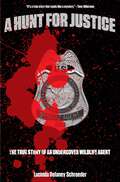- Table View
- List View
Humphrey the Hippo and the Search for Milk
by John RedstoneDeep in the mud pools and jungle forests of Hippoland lives Humphrey the Hippo. He is usually quite carefree compared to other hippos (who can be a bit grumpy at times). But one afternoon, he finds he is faced with a puzzle. Humphrey and his brother Harold are determined to make a cup of tea. But try as they might, they cannot find a key ingredient: milk.So, they decide to consult their friend, Wilberforce the Wizard, for he knows everything. Wilberforce uses his magic to send the hippos to the land of Humans (even though Harold thinks humans are &“mud sausages&”). In the land of Humans, the hippos cause all kinds of chaos, involving grocery stores, credit cards and bananas - amongst other things.But the two hippos persevere and return in triumph, with a carton of milk in hand, to Hippoland. However, their adventure is not over. They will still need the help of Wilbeforce the Wizard and his new mysterious friend, Clara.
Humphrey's Big Birthday Bash
by Betty G. Birney Priscilla BurrisHumphrey gets his first birthday party ever from the kids in Room 26.Kirk invites the class to his super-fun backwards birthday bash, where everything is backwards, including clothes! The kids in Room 26 have a great time, but they are sad when they realize that Humphrey, Og, and Ms. Brisbane aren't on the birthday calendar. Everyone starts whispering and Humphrey can only make out a few words, but he thinks he knows what they're planning--a birthday celebration for Ms. Brisbane! But when Friday comes around, Humphrey learns he was all wrong--the surprise party is for Humphrey and Og instead! With sweet illustrations and an easy reading level, Humphrey's Tiny Tales are hamster-iffic for emerging readers.
Humphrey's Creepy-Crawly Camping Adventure
by Betty G. Birney Priscilla BurrisEveryone's favorite classroom pet is now starring in chapter books!Humphrey has had lots of adventures as the classroom pet of Room 26, but never one like this. He is going on a campout in the backyard with Heidi and her friends! There's stargazing, roasting marshmallows, searching for creepy-crawlies--and then there are the prank-loving boys next door, who want to prove that the girls are scaredy-cats. Humphrey doesn't think girls are scaredy-cats. He doesn't think girls are like cats at all. Can this VERY-VERY-VERY small hamster show them with a hairy-scary trick of his own? With sweet illustrations and an easy reading level, Humphrey's Tiny Tales are hamster-iffic for emerging readers.
Humphrey's Mixed-Up Magic Trick
by Betty G. Birney Priscilla BurrisHumphrey might be the first classroom hamster ever to be part of a magic act! The kids in Room 26 are talking about jobs they want to have when they grow up. Golden-Miranda wants to be a magician and, even more exciting, she wants Humphrey to be her assistant when she shows the class some tricks. But when one of her tricks is in trouble, can Humphrey's quick thinking (and scampering) fix it in time? With sweet illustrations and an easy reading level, Humphrey's Tiny Tales are hamster-iffic for emerging readers.
Humphrey's Pet Show Panic
by Betty G. Birney Priscilla BurrisHumphrey is the favorite pet in Room 26, but will he also be a favorite at the pet show?When A.J. brings Humphrey to the town pet show, he's sure Humphrey will win a prize. But Humphrey isn't convinced. There are all kinds of animals in the show--from dogs and cats to parrots and even something called a bearded dragon! Humphrey tries to impress the judges with some tricks, but when a dog noses a little too close to him, Og the Frog saves the day with the most impressive trick of all. And Humphrey realizes that a great friend is the best prize ever.
Humphrey's Playful Puppy Problem
by Betty G. Birney Priscilla BurrisEveryone's favorite classroom pet is now starring in chapter books! Humphrey, the classroom hamster of Room 26, loves spending weekends with his classmates. This week, he is going home with Richie. Humphrey is going to help him with his science experiment (hamsters LOVE-LOVE-LOVE to be helpful). But Humphrey finds a surprise at Richie's house. Poppy the puppy is bouncy and barky and is eager to play--a little too eager, Humphrey thinks. Humphrey needs to get out of his cage to help Richie, but can he do that and stay out of Poppy's way at the same time? With adorable illustrations and an easy reading level, Humphrey's Tiny Tales are just right for emergent readers.
Humphrey's Really Wheely Racing Day
by Betty G. Birney Priscilla BurrisEveryone's favorite classroom pet is now starring in chapter books! Humphrey is one happy hamster. He lives in Room 26 at Longfellow School. He has a big comfy cage with a wheel perfect for spinning and a room full of friends. But when Humphrey goes to Mandy's house one weekend, he learns that her hamster has something Humphrey has never seen before--a hamster car! Humphrey wants one, too, but school is not usually the place for toys. Then his teacher talks about bringing in something special for a project. Is Humphrey getting a really wheely surprise? With adorable illustrations and an easy reading level, Humphrey's Tiny Tales are just right for emergent readers.
Humphrey's School Fair Surprise
by Betty G. Birney Priscilla BurrisEveryone's favorite classroom pet is now starring in chapter books!Longfellow School is having a school fair! They will have bouncy castles, bean bag games, painted faces, and delicious treats. And there's also a contest for best class spirit. Of course Mrs. Brisbane's class decides Humphrey and Og are the biggest reasons their class is so special and they make costumes and signs to show everyone why. At first it seems as though Humphrey and Og won't get to go to the fair, but luckily Aldo figures out a way to get them there safely. The fair is as wonderful as Humphrey imagined and he even ends up being the surprise star of the day.Just-right for readers transitioning from easy-to-reads to chapter books, Humphrey's Tiny Tales simply make kids HAPPY-HAPPY-HAPPY.
Humphrey's Shadow (Fountas & Pinnell Classroom, Guided Reading)
by Stephen Krensky Jeffrey EbbelerNIMAC-sourced textbook. Growing a Shadow. The sun is high overhead while Humphrey is working in his vegetable garden. Then Humphrey notices his shadow. It is small, much too small for a big elephant like him. If Humphrey waters his shadow, can he get his shadow to grow?
Humphrey's Treasure Hunt Trouble
by Betty G. Birney Priscilla BurrisHumphrey might be the only one who can solve the mystery of the missing treasure hunt prize! Garth has a surprise for his friends when they get to his party—a treasure hunt! Riddles are hidden all around his backyard and he put the prize in the best hiding spot of all—Humphrey’s cage. Only Humphrey knows something Garth doesn’t: someone stole the prize! Humphrey doesn’t know who took it, but he is good at solving mysteries. Can he put the clues together and save the treasure hunt? With sweet illustrations and an easy reading level, Humphrey’s Tiny Tales are hamster-iffic for emerging readers.
Humphrey's World of Pets
by Betty G. BirneyA fact book about animals and pet care hosted by Humphrey, everyone's favorite classroom pet! This nonfiction companion to the bestselling Humphrey series teaches readers all about animals and pet care. Filled with great facts about a variety of different animals, this book serves as a fun introduction to anyone interested in taking care of a pet. Also featured are cool tips, trivia, activities, and, of course, Humphrey himself to lead the way through it all! Nominated for twenty-four state awards and the winner of seven, the Humphrey series is a hit across the country. And he's becoming a one school/one-book favorite!
Humphrey, the Lost Whale: A True Story
by Wendy Tokuda Richard HallThe original book based on the true story of Humphrey, the Humpback whale who swam into the San Francisco Bay.
Humpty's Fall
by Dosh ArcherHumpty Dumpty arrives at City Hospital with a cracked shell. All the kings' men tried to help him, but all they did was make him leak yolk. Can he be fixed? With thickly illustrated pages, this story brings a unique twist to a well-known nursery rhyme, making it perfect for beginning readers who will wait to see if Doctor Glenda and Nurse Percy can save the day and put this egg back together again.
Hunde für Dummies (Für Dummies)
by Gina SpadaforiMit einem Hund durch dick und dünn - wer träumt nicht davon? Doch genügend Wissen über das Wesen und die Bedürfnisse des Hundes sind Voraussetzung für eine lebenslange Freundschaft. "Hunde für Dummies" bietet Ihnen alles, was Sie über Anschaffung, Ernährung, Verhalten, Erziehung und Gesundheit des Hundes wissen sollten. Lernen Sie auf verständliche und zugleich humorvolle Weise den richtigen Umgang mit Ihrem Hund und machen Sie so Ihren Vierbeiner und sich selbst zu glücklichen Partnern. Viele Tipps und Informationen zum Reisen und zum Sport mit Ihrem Hund, für ein liebevolles Verhältnis von Kindern und Hunden sowie ein spezielles Kapitel zum Leben mit einem alternden Hund machen dieses Buch zu einer Fundgrube für jeden Hundefreund.
Hundeerziehung für Dummies (Für Dummies)
by Jack Volhard Wendy VolhardMit der richtigen Methode lernt ein Hund gerne, was der Mensch von ihm will. Mit "Hundeerziehung für Dummies" erfahren Sie, wie Sie mit positiver Verstärkung Ihrem Hund alle wichtigen Kommandos beibringen, aber auch wie der Welpe stubenrein und das Stöckchen tatsächlich zurückgebracht wird. Das Autorenteam Jack und Wendy Volhard geben Ihnen Antworten auf Ihre brennenden Fragen: Wie spricht man ein Verbot aus und welche Hilfsmittel gibt es? Wieso lässt mich mein Hund nicht mehr auf das Sofa? Muss er mich zur Begrüßung wirklich immer anspringen? Diese freundliche und leicht verständliche Anleitung macht aus Herrchen und Frauchen stolze Hundebesitzer mit einem zufriedenen, gehorsamen Hund.
Hundetraining - Ein umfassender Ratgeber für Anfänger
by Nancy Ross Marlena TeitgeSie suchen einen Weg Ihren Hund ganz unkompliziert zu erziehen? In diesem Ratgeber finden Sie hilfreiche Tipps vom Thema Stubenrein bis hin zu den wichtigsten Kommandos, die Ihr Hund kennen sollte. Diese Themen erwarten Sie: Gründe Ihren Welpen zu erziehen Das Alphatier sein Gehorsamkeitstraining Stubenrein werden Hundebox-Training An der Leine laufen Die wichtigsten Kommandos Schlechte Verhaltensweisen korrigieren
Hundetraining zu Hause: Ein-Monats-Programm mit Tricks, Training und Tipps!
by Laura BernsGeheimnisse, mit denen Profis ihre Hunde trainieren! Anhand jahrzehntelang erprobter Strategien zeigt Ihnen dieses eBook den schnellsten und effektivsten Weg zur richtigen Erziehung Ihres Hundes. Sie lernen, wie Sie ihm Tricks beibringen und in nur 4 Wochen erziehen. Dieser Leitfaden für junge und erwachsene Hunde vermittelt positive Strategien, die jedes Mal funktionieren. Anhand sanfter und leicht auszuführenden Techniken, die auf Bestärkung setzen, bauen Sie eine Bindung und somit ein vertrauensvolles Verhältnis zu Ihrem Hund auf. Bringen Sie ihm neue Verhaltensweisen bei, oder nutzen Sie diese Strategien, um alte schlechte Gewohnheiten, die Ihr Hund möglicherweise entwickelt hat, zu korrigieren. Schritt für Schritt und einfach nachzuvollziehen. Inhalt: - Effizienter 4-wöchiger Trainingsplan. - Leicht nachvollziehbare Schritte. - Ihrem Hund zuhören. - Befehle geben. - Bestärkung. - Füttern und Leckerlis. - Stubenreinheit. - Tricks beibringen. + VIELES MEHR! Sie möchten Ihren Hund bestmöglich erziehen? Dann ist dieses Buch genau das Richtige für Sie. --> Blättern Sie zum Anfang der Seite, und klicken Sie für den Sofortkauf auf „In den Warenkorb legen“ Haftungsausschluss: Dieser Autor und/oder der/die Rechteinhaber erheben keine Ansprüche und machen keine Versprechungen oder Zusicherungen im Hinblick auf die Richtigkeit, Vollständigkeit oder Angemessenheit des Inhalts dieses Buches und lehnen ausdrücklich die Haftung für Fehler und Auslassungen beim Inhalt ab. Dieses Produkt ist nur als Nachschlagewerk gedacht. Bitte wenden Sie sich an einen Fachmann, bevor Sie Maßnahmen zu den darin enthaltenen Inhalten ergreifen.
Hundred Horse Farm (Cherrydale Farm #2)
by Blanche Chenery PerrinAfter their parents are killed in a car crash, twelve-year-old Ann and her younger brother Roddy come to live with Uncle Jim and Aunt Mary at their horse farm in Kentucky. At first their cousin Suzy feels a bit jealous at having to share not only her room with Ann but her beloved horses with both her cousins. Gradually, though, as Ann more and more displays a natural gift for riding, Suzy begins to take an interest in teaching her cousin the fine points of horsemanship. Even Roddy, after first trying to run away, perks up when he's given his own pony to ride and care for. The three cousins find themselves in plenty of adventures: When a prize horse is injured in a storm, Ann decides to look after him and make him hers; the horse-napping of one of the thoroughbreds leads to unexpected consequences. But to Ann and Roddy, the most important thing is being accepted as part of their new family, something that to Ann is closely connected with her own growing love for horses and riding. It isn't until Roddy and Ann enter their first horse show that all the cousins realize the real feelings they have for each other and their beloved Hundred Horse Farm. An exciting true-to-life story by a Thoroughbred racing insider whose real-life family bred and raced Secretariat and Riva Ridge.
Hungry Beautiful Animals: The Joyful Case for Going Vegan
by Matthew C. HaltemanA new approach to veganism "as a joyful celebration of life on this planet" (Bryant Terry) that is a "gateway into our Better" (Kathy Freston)—into a better life for us all Perhaps you&’ve looked at factory farming or climate change and thought, I should become a vegan. And like most people who think that, very probably you haven&’t. Why? Well, in our world, roast turkey emanates gratitude, steak confers virility, and chicken soup represents a mother&’s love. Against that, simply swapping meat for plants won&’t work. In Hungry Beautiful Animals, philosopher Matthew C. Halteman shows us how—despite all the forces arrayed against going vegan—we can create an abundant life for everyone without using animals for food. It might seem that moral rectitude or environmental judgement should do the trick, but they can&’t. Going vegan must be about flourishing, for all life. Shame and blame don&’t lead to flourishing. We must do it with joy instead. Hungry Beautiful Animals is more than philosophy: it&’s a book of action, of forgiveness, of love. Funny and wise, this book frees us joyfully to want what we already know we need.
Hungry Bird
by Jeremy TankardDo YOU ever get hangry?Bird is hiking with his friends when his tummy rumbles.But no one packed him a snack that he likes!With every step, his hunger mounts until he collapses on the ground.How will Bird survive if he doesn't eat the perfect something this instant?!The hilarious blue-feathered anti-hero who first starred in Jeremy Tankard's high-flying debut, Grumpy Bird, returns in another laugh out loud melodrama. For every child who has ever needed a snack right now, and for every parent who has had to cope with a hangry, fussy child, Hungry Bird is sure to satisfy.
Hungry Hen
by Richard WaringA greedy fox watches a hungry hen growing every day, knowing that the longer he waits to eat her, the bigger she will be.
Hungry Jim: (children's Emotion Books, Animal Books For Kids, Funny Children Books)
by Laurel SnyderWhen Jim wakes up one Tuesday morning, he doesn't feel like eating his pancakes. In fact, Jim doesn't feel like Jim. He feels rather, well, beastly. But he is hungry. Very hungry....This clever and relatable tale of moods from Laurel Snyder and Chuck Groenink offers a lighthearted depiction of the beastliness that lives inside all of us—and the power we have to put it in its place. Surprising yet satisfying, this richly illustrated book brims with humor that readers of all ages will be roaring to devour.
Hungry, Hungry Sharks! (Step into Reading)
by Joanna ColeIs your child hungry for nonfiction? This Step 3 SCIENCE READER will be sure to attract new readers to the fascinating subject of SHARKS! Did you know that there were sharks on earth even before dinosaurs? Nothing is more exciting than sharks, and this title is packed with amazing facts about these fearsome undersea predators. Step 3 Readers are for children who are ready to read on their own.
Huns & Hun Hunting
by Ben O. WilliamsHungarian partridge were first introduced to Saskatchewan 100 years ago.The birds flourished and soon expanded their range to include the American West and Midwest.Only in the last several decades have hunters turned serious attention to these tremendous game birds, but due to their fickle and often mysterious nature, the challenge has proven difficult at best for the majority of us.Ben O. Williams, however, has been writing about and hunting Huns for over 30 years, having accumulated over 5,000 hours afield in their pursuit with his ever evolving line of Brittany spaniels.Ben is the most accomplished and eloquent mentor for Hungarian partridge hunters presently found on planet earth, and this information packed book is the proof.Don't lend it to anyone, and don't lose it, for it provides you with all the distilled knowledge required to attain consistent success on your own Hun hunts.
Hunt for Justice: The True Story of an Undercover Wildlife Agent
by Lucinda SchroederNOW IN PAPERBACK! "A true story that reads like a mystery."—Tony Hillerman&“A suspenseful page-turner and a tale of true courage.&”—Ted Kerasote, author of Bloodties &“Schroeder illuminates an unusual, insular world with unflinching grit.&”—Publishers WeeklyFor thirty years Lucinda Delaney Schroeder held an unusual government position: She was one of a handful of women special agents with the U.S. Fish and Wildlife Service. In August 1992 she accepted an assignment that forever changed her life. The petite blonde left behind her husband and seven-year-old daughter in Wisconsin and posed as a divorcee big-game hunter in Alaska in order to infiltrate an international ring of poachers out for trophy wildlife. A Hunt for Justice takes readers along during Schroeder&’s dangerous mission. More than an adventure or true-crime tale, it is the story of a woman surviving in a male-dominated field, a woman against the wilderness, and a wife and mother risking it all for a cause she believes in. Selected for the 2007 Amelia Bloomer Project list of recommended feminist literature for young readers.
